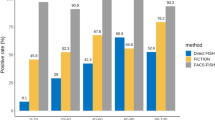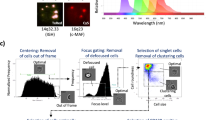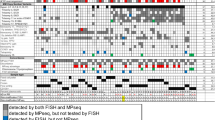Abstract
Fluorescence in situ hybridization (FISH) on interphase nuclei has been shown to be an efficient method for detecting aneuploidy in multiple myeloma (MM). The aim of this study was to test the feasibility of FISH techniques for detecting malignant cells in the harvests of MM patients submitted to autologous transplantation. As trisomy 9 (T9) is a frequent event in MM, we used it as a genetic marker of malignant plasma cells. T9 was detected in 45 out of 55 MM bone marrow samples (81.8%) using a chromosome 9 centromeric (C9C) probe. Twenty-four of the 55 MM patients were subjected to high-dose therapy followed by autologous unselected progenitor cell transplantation. Trisomy 9 was detected in 20 patients and was used as a marker of malignant cells. Upon karyotypic analysis, three of the four remaining patients without T9 showed an unbalanced translocation leading to a complete trisomy of the long arm of chromosome 1 (T1q). We thus used a 1q juxtacentromeric probe, pUC1.77, as another genetic marker of malignant plasma cells in these three further patients. FISH with C9C or pUC1.77 probes was performed on the harvests of these 23 patients and detected clonal cells in 11 transplants. The disease-free survival from graft was significantly longer for the patients who had no malignant cells in their transplant (P = 0.009). The median disease-free survival was 23 months in these patients, as compared to 12 months in the patients whose transplant was contaminated. As almost all MM are cytogenetically abnormal, FISH with adequate probes represents a simple, quantitative tool for rapid detection of malignant cells in the harvests. Our results also suggest that the presence of MM cells in the transplant may be predictive of poor outcome.
This is a preview of subscription content, access via your institution
Access options
Subscribe to this journal
Receive 12 print issues and online access
$259.00 per year
only $21.58 per issue
Buy this article
- Purchase on Springer Link
- Instant access to full article PDF
Prices may be subject to local taxes which are calculated during checkout
Similar content being viewed by others
Author information
Authors and Affiliations
Rights and permissions
About this article
Cite this article
Dascalescu, C., Callanan, M., Chauvet, M. et al. Interphase FISH: a rapid method for detecting malignant plasma cells in multiple myeloma patients submitted to autologous transplantation. Bone Marrow Transplant 23, 687–694 (1999). https://doi.org/10.1038/sj.bmt.1701626
Received:
Accepted:
Published:
Issue Date:
DOI: https://doi.org/10.1038/sj.bmt.1701626



